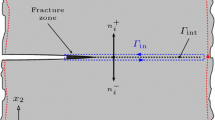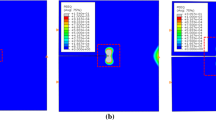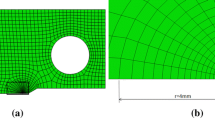Abstract
The growth of a sharp crack typically is accompanied by a damage or fracture process zone that propagates with the crack tip. The present understanding of the transient crack-tip fields under small-scale-creep conditions is limited primarily to analyses based upon creep flow rules that neglect damage. In this paper, Kachanov-type creep-damage constitutive equations are developed that include the dilatational creep that arises from caviation and microcrack damage. A finite element calculation demonstrates the effects of this type of creep-damage behavior on the asymptotic, singular crack-tip fields.
Résumé
La croissance d'une fissure aiguë est typiquement accompagnée d'une zone d'endommagement ou de rupture qui accompagne l'extrémité de la fissure tout au long de sa propagation.
La perception actuelle des champs transitoires à la pointe d'une fissure sous des conditions de fluage à petite échelle est essentiellement limitée à une analyse reposant sur les lois d'écoulement en fluage, sans considération d'endommagement. Dans cette étude, on développe les apparitions de type Kachanov représentatives du dommage par fluage, qui incluent le fluage en traction résultant de la cavitation et d'un endommagement par microfissures.
Un calcul par éléments finis démontre les effets de ce type de comportement d'endommagement par fluage sur les champs de contraintes singuliers et asymptotiques à l'extrémité d'une fissure.
Similar content being viewed by others
References
H. Riedel, Fracture at High Temperatures, Springer-Verlag (1987).
D.E. Hawk and J.L. Bassani, Journal of the Mechanics and Physics of Solids 34 (1986) 191–212.
J.L. Bassani, D.E. Hawk, and F.-H. Wu, in ASTM STP 995, American Society for Testing and Materials (1988) 68–95.
C.Y. Hui, International Journal of Solids and Structures 22 (1986) 357–372.
F.-H. Wu, J.L. Bassani, and V. Vitek, Journal of the Mechanics and Physics of Solids 34 (1986) 455–475.
J.L. Bassani, D.E. Hawk, and A. Saxena, in ASTM STP 995, American Society for Testing and Materials (1988) 7–26.
T. Gibbons, Report on International VAMAS Task Group on Creep Crack Growth, to appear (1988).
H. Riedel, International Journal of Fracture 42 (1990) 173–188.
H. Riedel, in Creep in Structures, A.R.S. Ponter and D.R. Hayhurst (eds.), Springer Verlag (1981) 504–519.
C.Y. Hui and V. Banthia, International Journal of Fracture 25 (1984) 53–67.
L.M. Kachanov, Jzvestiya Akademie Nauk SSSR Otd. Tech. Nauk., No. 8 (1958) 26–31.
L.M. Kachanov, Introduction to Continuum Damage Mechanics, Martinus Nijhoff (1986).
D.R. Hayhurst, Journal of the Mechanics and Physics of Solids 20 (1972) 381–390.
D.R. Hayhurst, P.R. Brown and C.J. Morrison, Philosophical Transactions of the Royal Society of London, A311 (1984) 131–158.
J.W. Hutchinson, Acta Metallurgica 31 (1983) 1079–1088.
V. Tvergaard, International Journal of Fracture 31 (1986) 183–209.
A.S. Argon, C.W. Lau, B. Ozmat, and D.M. Parks, in Fundamentals of Deformation and Fracture, B.A. Bilby, J.J. Miller, and J.R. Willis (eds.), Cambridge University Press, England (1985) 243–262.
G.J. Rodin and D.M. Parks, Mechanics of Materials 5 (1986) 221–228.
F.Z. Li, A. Needleman and C.F. Shih, International Journal of Fracture 38 (1988) 241–273.
J.L. Bassani and V. Vitek, in Nonlinear Fracture Mechanics, L.B. Freund and C.F. Shih (eds.), Proceedings of 14th U.S. National Congress of Theoretical and Applied Mechanics (1982) 127–133.
J.L. Bassani and D.E. Hawk, in Proceedings of MECAMAT International Seminar on High Temperature Fracture Mechanisms and Mechanics, P. Bensussan et al. (eds.) MECAMET, Moissy-Cramayet (1987) 19–40.
J.L. Bassani, Materials Science and Engineering A103 (1988) 115–123.
H. Riedel and J.R. Rice, ASTM STP 700, American Society for Testing and Materials (1980) 112–130.
J.L. Bassani and F.A. McClintock, International Journal of Solids and Structures 17 (1981) 479–492.
C.Y. Hui and H. Riedel, International Journal of Fracture 17 (1981) 409–425.
H. Riedel, in Fundamentals of Deformation and Fracture, B.A. Bilby, K.J. Miller, and J.R. Willis (eds.), Cambridge University Press, England (1985) 293–309.
M.B. Kanchi, O.C. Zienkiewicz and D.R.J. Owen, International Journal for Numerical Methods in Engineering 12 (1978) 169–181.
D.E. Haw, Ph.D. thesis, University of Pennsylvania (1986).
I.C. Cormeau, International Journal of Numerical Methods in Engineering 9 (1975) 109–127.
J.C. Nagtegaal, D.M. Parks, and J.R. Rice, Computer Methods in Applied Mechanics and Engineering 4 (1974) 153–177.
H. Akima, ACM Transactions Math Software 4 (1978) 148–159.
Author information
Authors and Affiliations
Rights and permissions
About this article
Cite this article
Bassani, J.L., Hawk, D.E. Influence of damage on crack-tip fields under small-scale-creep conditions. Int J Fract 42, 157–172 (1990). https://doi.org/10.1007/BF00018384
Received:
Accepted:
Issue Date:
DOI: https://doi.org/10.1007/BF00018384




